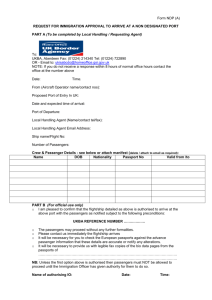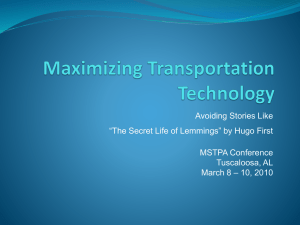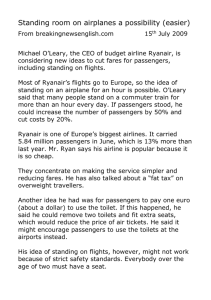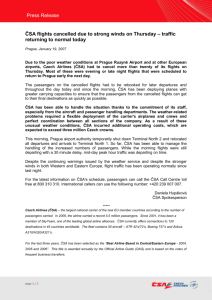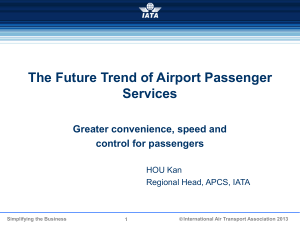Passenger Flow Simulation (PFS) In A Complex Networked Transportation System Danyi Wang
advertisement
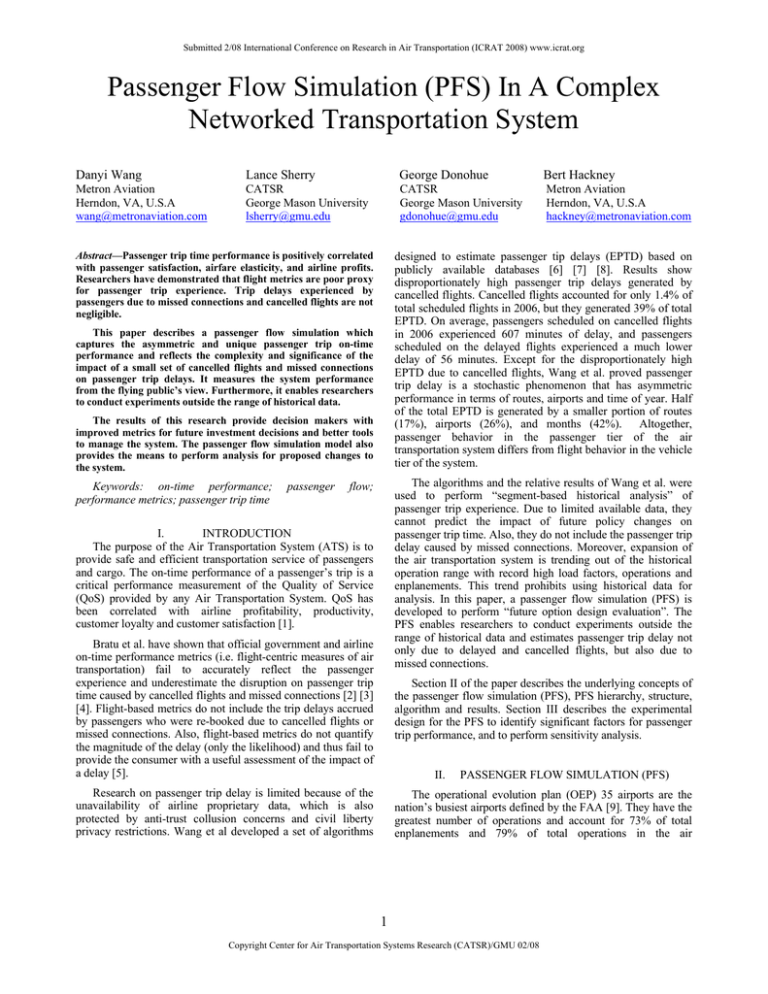
Submitted 2/08 International Conference on Research in Air Transportation (ICRAT 2008) www.icrat.org Passenger Flow Simulation (PFS) In A Complex Networked Transportation System Danyi Wang Lance Sherry George Donohue Bert Hackney Metron Aviation Herndon, VA, U.S.A wang@metronaviation.com CATSR George Mason University lsherry@gmu.edu CATSR George Mason University gdonohue@gmu.edu Metron Aviation Herndon, VA, U.S.A hackney@metronaviation.com designed to estimate passenger tip delays (EPTD) based on publicly available databases [6] [7] [8]. Results show disproportionately high passenger trip delays generated by cancelled flights. Cancelled flights accounted for only 1.4% of total scheduled flights in 2006, but they generated 39% of total EPTD. On average, passengers scheduled on cancelled flights in 2006 experienced 607 minutes of delay, and passengers scheduled on the delayed flights experienced a much lower delay of 56 minutes. Except for the disproportionately high EPTD due to cancelled flights, Wang et al. proved passenger trip delay is a stochastic phenomenon that has asymmetric performance in terms of routes, airports and time of year. Half of the total EPTD is generated by a smaller portion of routes (17%), airports (26%), and months (42%). Altogether, passenger behavior in the passenger tier of the air transportation system differs from flight behavior in the vehicle tier of the system. Abstract—Passenger trip time performance is positively correlated with passenger satisfaction, airfare elasticity, and airline profits. Researchers have demonstrated that flight metrics are poor proxy for passenger trip experience. Trip delays experienced by passengers due to missed connections and cancelled flights are not negligible. This paper describes a passenger flow simulation which captures the asymmetric and unique passenger trip on-time performance and reflects the complexity and significance of the impact of a small set of cancelled flights and missed connections on passenger trip delays. It measures the system performance from the flying public’s view. Furthermore, it enables researchers to conduct experiments outside the range of historical data. The results of this research provide decision makers with improved metrics for future investment decisions and better tools to manage the system. The passenger flow simulation model also provides the means to perform analysis for proposed changes to the system. Keywords: on-time performance; performance metrics; passenger trip time passenger The algorithms and the relative results of Wang et al. were used to perform “segment-based historical analysis” of passenger trip experience. Due to limited available data, they cannot predict the impact of future policy changes on passenger trip time. Also, they do not include the passenger trip delay caused by missed connections. Moreover, expansion of the air transportation system is trending out of the historical operation range with record high load factors, operations and enplanements. This trend prohibits using historical data for analysis. In this paper, a passenger flow simulation (PFS) is developed to perform “future option design evaluation”. The PFS enables researchers to conduct experiments outside the range of historical data and estimates passenger trip delay not only due to delayed and cancelled flights, but also due to missed connections. flow; INTRODUCTION I. The purpose of the Air Transportation System (ATS) is to provide safe and efficient transportation service of passengers and cargo. The on-time performance of a passenger’s trip is a critical performance measurement of the Quality of Service (QoS) provided by any Air Transportation System. QoS has been correlated with airline profitability, productivity, customer loyalty and customer satisfaction [1]. Bratu et al. have shown that official government and airline on-time performance metrics (i.e. flight-centric measures of air transportation) fail to accurately reflect the passenger experience and underestimate the disruption on passenger trip time caused by cancelled flights and missed connections [2] [3] [4]. Flight-based metrics do not include the trip delays accrued by passengers who were re-booked due to cancelled flights or missed connections. Also, flight-based metrics do not quantify the magnitude of the delay (only the likelihood) and thus fail to provide the consumer with a useful assessment of the impact of a delay [5]. Section II of the paper describes the underlying concepts of the passenger flow simulation (PFS), PFS hierarchy, structure, algorithm and results. Section III describes the experimental design for the PFS to identify significant factors for passenger trip performance, and to perform sensitivity analysis. II. Research on passenger trip delay is limited because of the unavailability of airline proprietary data, which is also protected by anti-trust collusion concerns and civil liberty privacy restrictions. Wang et al developed a set of algorithms PASSENGER FLOW SIMULATION (PFS) The operational evolution plan (OEP) 35 airports are the nation’s busiest airports defined by the FAA [9]. They have the greatest number of operations and account for 73% of total enplanements and 79% of total operations in the air 1 Copyright Center for Air Transportation Systems Research (CATSR)/GMU 02/08 Submitted 2/08 International Conference on Research in Air Transportation (ICRAT 2008) www.icrat.org transportation system [10]. The passenger flow simulation is a closed network formed by 34 of the OEP-35 airports. Honolulu international airport (HNL) is excluded due to its geographic location and negligible impact on the network. timed, Colored Petri Net (CPN) is built in “CPN Tools” to simulate passenger flow and connecting processes in the system. CPN Tools is a graphical user interface for editing, simulating and analyzing Colored Petri Nets [13]. CPN Tools can model the complex level of interactions in the air transportation system visually by creating nodes, transitions and arcs in the model environment. This visual modeling environment allows people to track and understand the behavior of each passenger easily. A. The Underlying Concept Air transportation simulations of flight movement do not capture the passenger flow and connecting process. In the air transportation network, passengers cluster together into groups to fly from one airport to another. After arrival at the destination airport, this group of passengers breaks up: nonstop passengers make connections to ground transportation, and connecting passengers continue their trips by re-clustering with other passengers. Compared with the flight movement, passenger movement The concept of “color” distinguishes tokens (or resources) in the net. “PaxGroup” is defined as a color in PFS: Color: PaxGroup = (Origin) * (Dest) * (# of Pax Loaded) * (Aircraft Size) * (SchDeptime) * (SchArrTime) * (Carrier) * (FlightIndex) * (# of Local Pax) timed; For example, the PaxGroup (DCA, ORD, 185, 200, 730, 850, 13, 45, 165)@+750 in Figure 1 represents a group of 185 passengers, loaded on United Airlines flight 45 with 200 seats, scheduled to depart from DCA at system time 730, and arrived at ORD at system time 850. However, this flight actually they departed at system time 750, which is 20 minutes later than scheduled. Of the 180 loaded passengers, 165 are local passengers*, and 15 are connecting passengers. • Simulates passenger behavior instead of flight behavior; • Converts flight information, such as arrival time and origin and destination airports, into attributes of passengers or groups of passengers; • Converts flight schedules into scattering rules followed by passengers. clustering and B. Colored Petri Net Modeling Tool A Petri Net is a graphical and mathematical modeling tool. It is well-suited to model public transportation networks [11], and has been used to model the passenger connecting process in a public bus transportation system [12]. Tokens in places (circles) represent available resources to enable a transition (rectangle). The left part of Figure 1 shows one group of passengers in place “local pax” and two groups of connecting passengers in place “conn pax”. The first group of 20 connecting passengers arrived at the gate at time 715, and the second group of 15 connecting passengers arrived at the gate at 770. When flight departed at time 750, the first group of passengers was loaded on time, whereas the second group of connecting passengers missed their connections since they arrived at the gate after the flight departed. The right part of Figure 10 shows the CPN after the transition fired: one group of connecting passengers were still waiting to be loaded at the gate, and a group of 185 passengers (165 local + 20 connecting) were ready to gate out. For an accurate modeling of a complex transportation system like the air transportation system, a more complicated extension of Petri Net is required. In this paper, a hierarchical, C. PFS Overview The passenger flow simulation (PFS) is built to simulate this dynamic clustering and scattering process of passenger flow in the system. Air transportation simulations of flight movement do not capture the passenger flow and connecting process. Figure 1 Example: passenger loading process in CPN Local passengers* are passengers who just appear in the air transportation system. They could be either nonstop passengers from DCA to ORD, or connecting passengers whose first leg flight is from DCA to ORD. 2 Copyright Center for Air Transportation Systems Research (CATSR)/GMU 02/08 Submitted 2/08 International Conference on Research in Air Transportation (ICRAT 2008) www.icrat.org Figure 2. Big Picture: Correlation between Algorithms and PFS Figure 2 depicts the correlations between algorithms and PFS. The algorithm section above the dotted line targets the “historical analysis.” In this section, different algorithms are designed to manipulate the data in different data processing phases. The “historical analysis” section sets the stage for “future option design evaluation.” As shown in Figure 2, processed data, algorithms, and the analysis report are embedded into the passenger flow simulation model as parameters, logical structure and initial tokens. In other words, the parameter setting and passenger flow control in the PFS are based on historical statistics calculated by algorithms. TABLE 1 scheduled on a specific flight (e.g. UAL123 on route ORDDCA) will arrive at the actual arrival time (e.g. 1145). But in the stochastic PFS, the flight time is determined by a set of random number generators with specific means and standard deviations (e.g. flight time for UAL flights on route ORD-DCA is a normal random variable with µ=100 minutes and σ=15 minutes). Thus the arrival time for flight UAL123 is a stochastic value generated as “DepTime + NormRNG (µ=100, σ=15)”. In summary, the deterministic PFS is a pure conversion between flight performance and passenger performance, whereas the stochastic PFS allows flexibility and is more suitable for future option design evaluation. OVERVIEW OF PASSENGER FLOW SIMULATION (PFS) STRUCTURE Aspects Description Airports OEP-34 airports (excluding HNL) Routes 1,030 routes formed by OEP-34 airports Carrier 17 major carriers Daily Flights Daily Enplanements 8,500 900,000 PFS Mode Deterministic and Stochastic Hierarchy 3-level Places 580 Transitions 343 Functions Initial Tokens Functions D. PFS Hierarchy The PFS has three levels as shown in Figure 3. Airport and En-Route subnets are represented as substitute transitions in the top-level net of PFS. Zoom-in figures of the top-level, secondlevel and the third-level nets are shown in the Appendix A. The top-level page depicts 34 airport substitute transitions, a single en route substitute transition, and the 68 ports connecting them. A zoom-in figure of Washington-National Airport (DCA) shows an aggregated departure gate and an aggregated arrival gate for each airport. An airport substitution transition is directionally connected to and from en-route substitution through two ports, one representing arrival gate and the other representing departure gate (Appendix A Figure A.1). 42 20,000 42 In the second-level airport subnet, the flow process of passengers inside the airport boundary is divided into three steps: (1) splitting PaxGroup, (2) re-clustering of PaxGroup and (3) loading PaxGroup. Arriving PaxGroup to the airport split into two sub-groups. One group is connecting passengers who use the airport as connecting hub, and the other group are passengers whose itineraries end here at the airport. In step The network structure of PFS is formed by 34 of the OEP35 airports, and the 1030 routes between them. Passengers flow from one airport to another through the existing routes. Table 1 gives an overview of the PFS structure. The PFS has two modes: deterministic and stochastic. They share the same PFS structure, but with different functions and parameter values. In the deterministic PFS, passengers 3 Copyright Center for Air Transportation Systems Research (CATSR)/GMU 02/08 Submitted 2/08 International Conference on Research in Air Transportation (ICRAT 2008) www.icrat.org two, connecting passengers are re-clustered to form a new group for the second-leg flights. Finally, the newly formed PaxGroup is loaded to their flights and ready to gate-out (Appendix A Figure A.2). Functions written in the transition code segment and on the arcs are responsible for guiding the passenger flow according to historical statistics. For example, the splitting ratio of connecting or non-connecting passengers is obtained from historical DB1B data. obtain passenger connecting information given flight schedule. Then passenger connecting information is fed to the experimental scenario, which simulates the real world with delays, cancellations and missed connections. As shown in In the second-level en route subnet, PaxGroup goes through taxi-out, air time, taxi-in, and finally reaches the arriving gate of destination airports (Appendix A Figure A.3). The taxi-out time, air time and taxi-in time are generated by functions. These functions are random number generators following some distributions with specific means and standard deviations. Figure 4. Passenger Missed Connection Algorithm in PFS Figure 4, passenger connecting information provided by base scenario enables us to conduct research on missed connection in the experimental scenario. The simulation results of the experimental scenario estimate EPTD not only due to delayed and cancelled flights, but also due to missed connections. F. PFS Sample Results July 6, 2005 is a randomly chosen weekday in summer 2005. Flight performance on July 6, 2005 was as follows: • Scheduled Flights = 8,540 fights; • Delayed Flights = 1,764 fights = 21% of Scheduled Flights; • Cancelled Flights = 176 fights = 2% of Scheduled Flights. Figure 3. PFS Hierarchy In the third-level passenger loading subnet, general connecting passengers flow to the upper branch and then are loaded to the scheduled flights, while disrupted passengers, such as missed-connection and cancelled, flow to the lower branch and wait to be re-booked. Flights finished loading general connecting passengers will check for disrupted passengers before they depart. If disrupted passengers are detected, flights with available empty seats will load them until either no more seats are available or there are no more disrupted passengers. The general connecting passengers (upper branch) have higher priority than cancelled or missed connection passengers (lower branch). Passengers on both branches are sorted into first-come-first-serve airline queues to ensure passengers will be loaded on the correct flights (purchased flights) or will be re-booked by the same airline if disrupted (Appendix A Figure A.4). PFS simulates passenger flow and calculates passenger trip delays on July 6, 2005. As shown in Figure 5, 2% of cancelled passengers generated 30% of total EPTD, 1% of missed connection passengers generated 15% of total EPTD, and 21% of delayed passengers generated 55% total EPTD. On average, passengers scheduled on cancelled flights experienced 403 minutes of delay, missed connection passengers experienced 341 minutes of delay, and passengers scheduled on delayed flights experienced 64 minutes of delay. E. Passenger Missed Connection Algorithm in PFS Each experiment of PFS has two scenarios: base scenario and experiment scenario. Base scenario simulates passenger flow in an ideal environment without disruptions such as flight delays or cancellations. The goal of running base scenario is to 4 Figure 5. PFS Simulation Result for July 6, 2005 Copyright Center for Air Transportation Systems Research (CATSR)/GMU 02/08 Submitted 2/08 International Conference on Research in Air Transportation (ICRAT 2008) www.icrat.org • To reduce EPTD due to cancelled flights: encourage III. EXPERIMENT DESIGN FOR PFS The purpose of the experiment design is to identify and rank the significant factors that have strong impacts on passenger trip time, and to analyze the sensitivity of EPTD given changes in these factors. Based on the literature, six factors representing passenger, seat, flight performance and policy, are chosen as initial significant factors. A full factorial design for six factors assuming a linear response function, needs 26 = 64 total runs, and each run requires two PFS scenarios (base and experimental scenarios). In total, 128 PFS models need to be built and executed for a full factorial design. Concerned about time, we performed a fractional factorial design with six factors, two levels (high and low) and 1/8 fraction. Table 2 lists the six factors and their high/low level. TABLE Figure 6. Rank Order of Factors for Total EPTD 2 HIGH AND LOW LEVEL SETTINGS FOR FACTORS Factors # Passengers Loaded Aircraft Size Airline Cooperation Policy Flight Delay Cancellation Time Minimal Connecting Time High Increased by 5% Increased by 15% Y + 15 minutes Cancelled four hours earlier + 15 minutes airline cooperation, lower load factor, and earlier cancellation time Low Decreased by 15% Decreased by 5% N - 15 minutes Remain the same cancellation time - 15 minutes • To reduce EPTD due to missed connections: decrease flight delay, decrease minimal connecting time required and encourage earlier cancellation time • To reduce EPTD due to delayed flights: less flight delay and less passengers loaded. A simple sensitivity analysis is done for a better understanding of impact of factors on EPTD. As shown in Table 3, change in single factor can result in 8% to 24% less total EPTD, and thereby savings of millions of dollars per day. The high and low levels of “# of passengers” and “aircraft size” are designed to keep load factor in the range of [61%, 92%]. The highest value of load factor (92%) occurs in experiments with “# pax”=H and “aircraft size”=L, while the lowest value of load factor (61%) occurs in experiment with “# pax”=L and “aircraft size”=H. Airline cooperation policy indicates whether airlines on the same route cooperate with each other on re-booking disrupted passengers. If not, disrupted passengers have to stick with the same airline for rebook. TABLE 3 SENSITIVITY OF THE TOTAL EPTD (DELAY+CANCEL+MISSCONN) TO CHANGES IN FACTORS Changes in a single factor The rank order of significant factors in terms of the absolute value of coefficients for NAS-wide total EPTD is depicted in Figure 6. The most significant factor to total EPTD is flight delay, which is obvious, since more than half of the total EPTD is due to delayed flights. Along with flight delay, number of passengers, flight cancellation time and airline cooperation policy also have significant impacts on total EPTD. Reduce flight delay by 15 minutes Encourage airline cooperation Cancel flights 4 hrs earlier Reduce load factor from 83% to 70% Compared with Total EPTD on July 6, 2005 Decrease in total EPTD (hours per day) Passenger Value of Time Saved (million $ per day) Decreased by 24% Save $2.3 million Decreased by 12% Save $ 1.1 million Decreased by 10% Save $ 0.9 million Decreased by 8% Save $ 0.7 million Officials, operators and service providers should consider the combined effect of factors on EPTD, which helps to achieve the strategic goals with minimal changes or costs. The rank order changes from case to case. For example, the rank order of factors in terms of EPTD due to cancelled flights is: airline cooperation policy, aircraft size and number of passengers (or load factor), flight cancellation time. These three factors have stronger impacts on EPTD due to cancelled flights than any other factors, since they are directly related to re-book flexibility and resource availability. IV. CONCLUSIONS The goal of Air Transportation Service is to provide safe, affordable, and convenient transport for passengers and cargo. As a consequence, the top level performance measures of the ATS should include the trip delays experienced by airline passengers. Passenger-based metrics, together with flight-based In summary, the significant factors for different cases are as follows: • To reduce total EPTD: decrease flight delay, encourage airline cooperation, earlier cancellation time, and lower load factor 5 Copyright Center for Air Transportation Systems Research (CATSR)/GMU 02/08 Submitted 2/08 International Conference on Research in Air Transportation (ICRAT 2008) www.icrat.org metrics, can give a more accurate and complete description of the ATS performance. [9] [10] The passenger flow simulation (PFS) captures the asymmetric and unique passenger trip on-time performance and reflects the complexity and significance of the impact of a small set of cancelled flights and missed connections on passenger trip delays. Major findings of this research are listed as follows: [11] [12] 1) High passenger trip delays are disproportionately generated by cancelled flights and missed connections. 2) Passenger-based metrics are needed to capture the passenger travel experience, since flight-based metrics can unintentionally distort the actual performance of the system and effectively “hide” explanatory and diagnostic system behavior. [13] Federal Aviation Administration (2004), Airport Capacity Benchmark Report 2004. Bhadra, D., Texter, P. (2005), Airline networks: an economietric framework to analyze domestic US air travel, Journal of Transportation and Statistics, Vol. 7 Number 1. Castelain, E., Mesghouni, K (2002), Regulation of a public transport network with consideration of the passenger flow modeling of the system with high-level Petri nets, Systems, Man and Cybernetics, IEEE International Conference, Volume 6, 6-9 Turki, A., Grunder, O. and Moudni, A. (2002), Public transportation systems modeling and analysis based on a new Petri net approach, in Proceedings of the 2nd IEEE International Conference on Systems, Man and Cybernetics (SMC'02), October 6-9, 2002, Hammamet, Tunisia, Volume 5. Colored Petri Net (CPN) Tools : http://wiki.daimi.au.dk/cpntools/cpntools.wiki 3) Congestion flight delay, load factor, flight cancellation time and airline cooperation policy are the most significant factors affecting total EPTD in the system. The combined effect of multiple factors should be investigated and used to support the decisions made by officials, policy makers and researchers. 4) Passengers should treat trip time as a stochastic phenomenon that can be assigned a probability of occurrence, but cannot be avoided entirely in any systematic manner. Simple strategies can be used by passengers to reduce the probability of occurrence, such as choice of departure airport and route. For example, for a trip from Washington D.C. to Chicago, flights from DCA to MDW had a 5% probability of more than one hour delay, whereas the flight from DCA to ORD had 12% of probability of more than one hour delay. REFERENCES [1] [2] [3] [4] [5] [6] [7] [8] Heskett, J., Jones, T., Loveman, G., Sasser, W. and Schlesinger, L. (1994), Putting the Service-Profit Chain to Work, Harvard Business Review, March-April 1994, 164-174. Bratu, S. (2003), Airline Passenger On-Time Schedule Reliability: Analysis, Algorithms and Optimization Decision Models, Ph.D Thesis, Supervisor: Cythia Barnhart, Massachusetts Institute of Technology, Cambridge, MA. Bratu, S., Barnhart, C. (2005), An Analysis of Passenger Delays Using Flight Operations and Passenger Booking Data, Air Traffic Control Quarterly, Number 1, Volume 13. Bratu, S. and Barnhart, C. (2006), Flight Operations Recovery: New Approaches Considering Passenger Recovery, Journal of Scheduling, Volume 9, issue 3, Page: 273-298, June 2006 Wang, D., Sherry, L., Xu, N. and Donohue, G. (2007), System Analysis of Flight and Passenger Trip Delays in the National Airspace System, the 26th Digital Avionics Systems Conference, October 2007. Wang, D. (2007), Methods For Analysis Of Passenger Trip Performance In A Complex Networked Transportation System, PhD Thesis, Supervisor: Lance Sherry, Systems Engineering and Operations Research Department, George Mason University, Fairfax VA Sherry, L., Wang, D. and Donohue, G. (2007), Air Travel Consumer Protection: A Metric for Passenger On-Time Performance, Journal of the Transportation Research Board, ISSN: 0361-1981, pp 22-27. Wang, W., Sherry, L. and Donohue, G. (2006), Passenger Trip Time Metrics, Proceeding of the 2nd International Conference on Research in Air Transportation (ICRAT), Belgrade 6 Copyright Center for Air Transportation Systems Research (CATSR)/GMU 02/08 Submitted 2/08 International Conference on Research in Air Transportation (ICRAT 2008) www.icrat.org Appendix A Figure A.1 7 Copyright Center for Air Transportation Systems Research (CATSR)/GMU 02/08 Submitted 2/08 International Conference on Research in Air Transportation (ICRAT 2008) www.icrat.org Figure A.2 Figure A.2 Figure A.3 8 Copyright Center for Air Transportation Systems Research (CATSR)/GMU 02/08 Submitted 2/08 International Conference on Research in Air Transportation (ICRAT 2008) www.icrat.org Figure A.4 9 Copyright Center for Air Transportation Systems Research (CATSR)/GMU 02/08
